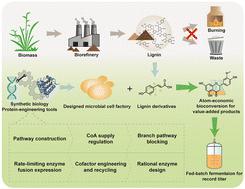当前位置:
X-MOL 学术
›
Green Chem.
›
论文详情
Our official English website, www.x-mol.net, welcomes your feedback! (Note: you will need to create a separate account there.)
Pathway and enzyme engineering for the bioconversion of lignin derivatives into homoeriodictyol in Saccharomyces cerevisiae
Green Chemistry ( IF 9.8 ) Pub Date : 2024-03-12 , DOI: 10.1039/d4gc00183d Si-Yu Zhu 1, 2 , Shi-Chang Liu 1, 2 , Chuan-Xi Zhang 3 , Xin Xin 1, 2 , Zhi-Hua Liu 1, 2 , Lu-Jia Zhang 4, 5 , Bing-Zhi Li 1, 2 , Ying-Jin Yuan 1, 2
Green Chemistry ( IF 9.8 ) Pub Date : 2024-03-12 , DOI: 10.1039/d4gc00183d Si-Yu Zhu 1, 2 , Shi-Chang Liu 1, 2 , Chuan-Xi Zhang 3 , Xin Xin 1, 2 , Zhi-Hua Liu 1, 2 , Lu-Jia Zhang 4, 5 , Bing-Zhi Li 1, 2 , Ying-Jin Yuan 1, 2
Affiliation

|
A sustainable lignin bioconversion depends on the exploitation of the inherent aromaticity of lignin for high-value aromatic products. However, the microbial valorization of lignin is hindered by the lack of established bioconversion routes or the inefficient heterologous expression of key enzymes. Here, an efficient biological lignin conversion route was constructed in a microbial cell factory by tapping the inherent aromaticity of lignin to produce aromatic natural compounds such as homoeriodictyol. The heterologous biosynthesis pathways were successfully constructed to convert lignin-derived monomers to homoeriodictyol in Saccharomyces cerevisiae. The implementation of combinatorial regulating strategies resulted in enhanced CoA supply, suppression of branch pathways, and upregulation of the rate-liming enzymes, which increased the titer of homoeriodictyol by a remarkable 22.5-fold. After that, engineering cofactor supply and recycling led to a substantial 95% increase in homoeriodictyol production. The rational design and modification of the heterologous rate-limiting enzymes helped achieve substantial improvement in the homoeriodictyol yield. All these strategies together enabled the record homoeriodictyol titer of 3.2 mmol l−1 from lignin derivatives by S. cerevisiae. Overall, such an innovative conversion route meets the atom-economy concept by converting lignin derivatives into valuable flavonoids, paving a green, sustainable way for both the valorization of lignin and the production of aromatic natural products.
中文翻译:

酿酒酵母中木质素衍生物生物转化为高圣草酚的途径和酶工程
可持续的木质素生物转化取决于利用木质素固有的芳香性来生产高价值的芳香产品。然而,由于缺乏已建立的生物转化途径或关键酶的低效异源表达,木质素的微生物增值受到阻碍。在此,在微生物细胞工厂中构建了一条高效的生物木质素转化路线,通过利用木质素固有的芳香性来生产芳香族天然化合物,如高圣草酚。成功构建了异源生物合成途径,将木质素衍生的单体转化为酿酒酵母中的高圣草酚。组合调节策略的实施导致 CoA 供应增强、分支途径抑制和限速酶上调,从而使高圣草酚的滴度显着增加了 22.5 倍。此后,工程辅因子供应和回收导致同圣草酚产量大幅增加 95%。异源限速酶的合理设计和修饰,实现了高圣草酚得率的大幅提高。所有这些策略共同实现了酿酒酵母木质素衍生物的同圣草醇滴度创纪录的 3.2 mmol l -1。总体而言,这种创新的转化路线通过将木质素衍生物转化为有价值的黄酮类化合物,满足了原子经济的概念,为木质素的增值和芳香天然产物的生产铺平了一条绿色、可持续的道路。
更新日期:2024-03-12
中文翻译:

酿酒酵母中木质素衍生物生物转化为高圣草酚的途径和酶工程
可持续的木质素生物转化取决于利用木质素固有的芳香性来生产高价值的芳香产品。然而,由于缺乏已建立的生物转化途径或关键酶的低效异源表达,木质素的微生物增值受到阻碍。在此,在微生物细胞工厂中构建了一条高效的生物木质素转化路线,通过利用木质素固有的芳香性来生产芳香族天然化合物,如高圣草酚。成功构建了异源生物合成途径,将木质素衍生的单体转化为酿酒酵母中的高圣草酚。组合调节策略的实施导致 CoA 供应增强、分支途径抑制和限速酶上调,从而使高圣草酚的滴度显着增加了 22.5 倍。此后,工程辅因子供应和回收导致同圣草酚产量大幅增加 95%。异源限速酶的合理设计和修饰,实现了高圣草酚得率的大幅提高。所有这些策略共同实现了酿酒酵母木质素衍生物的同圣草醇滴度创纪录的 3.2 mmol l -1。总体而言,这种创新的转化路线通过将木质素衍生物转化为有价值的黄酮类化合物,满足了原子经济的概念,为木质素的增值和芳香天然产物的生产铺平了一条绿色、可持续的道路。



























 京公网安备 11010802027423号
京公网安备 11010802027423号